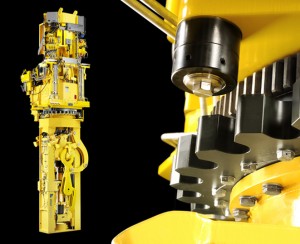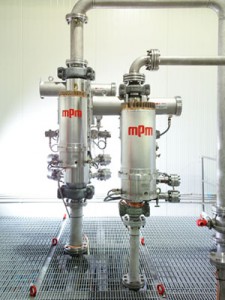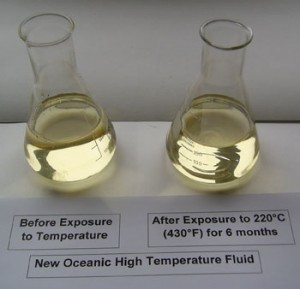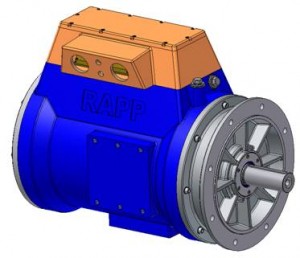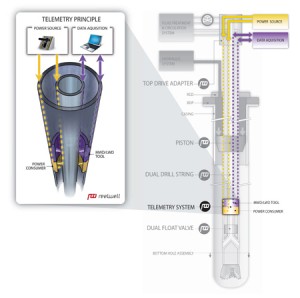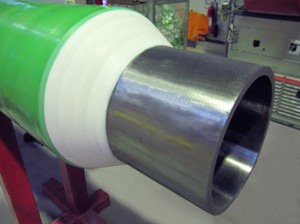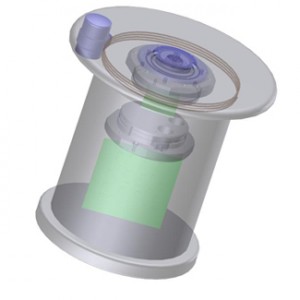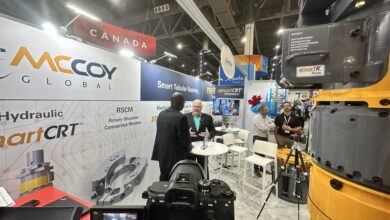2010 OTC Spotlight on New Technology Award Winners
This year, OTC recognized 13 technologies from 12 companies (two from Schlumberger) for their Spotlight on New Technology Award. Winners are selected based upon five criteria:
- The technology must be less than two years old;
- The technology must be original, groundbreaking and capable of revolutionizing the offshore E&P industry;
- The technology must be proven, either through full-scale application or successful prototype testing;
- The technology must have broad interest and appeal for the industry;
- The technology must provide significant benefits beyond existing technologies.
Aker Solutions notes that its MH MDDM 1000™ top drive drilling system is the “first true modular derrick drilling machine that meets sixth generation drilling requirements.” It is designed to provide 99.9% uptime per year, which is achievable due to its modular concept allowing easy access for replacement of individual modules. This reduces the critical path of the operation resulting in reduced time to repair from days to hours. When a part or module breaks down, the specific module can be replaced without interrupting other top drive systems. Additionally, the downtime of overhauls and annual load path inspections is reduced. Typically, these operations can only be conducted offline. Also, the modular design and the number of quick connector devices reduce assembly time.
Developed with the support of Petrowell Ltd., Expro’s FlowCAT™ Wireless Safety Valve System can be retro-fitted into a well using conventional slickline intervention equipment and procedures. FlowCAT is controlled using Expro’s Cableless Telemetry System (CaTS) technology. It can be retrofitted into a well after the tubing retrievable safety valve of control line has failed.
The fail-safe closed design FlowCAT is controllable from the surface and offers both functional and safety advantages over existing surface controlled subsurface safety valve (SSCSV) solutions. It utilizes non-elastomer sealing faces for enhanced sealing and increased well safety. The valve system also offers a retrofit solution where no hydraulic control line is installed. Where a capillary string may need to be installed for foam injection purposes, it provides an opportunity to free up the hydraulic control line. FlowCAT does not require modification to or recertification of the wellhead components.
The Self Configuring Multi Phase Meter (MPM) developed by FMC’s Multi Phase Meter subsidiary acquired in 2009 employs tomographic technology to significantly improve measurement accuracy and measurement range for topside and subsea applications. Seven patented technologies make the meter significantly more accurate and robust than existing products, according to the company. The self calibrating feature allows it to detect and measure water salinity in combination with other liquids in a well, resulting in a higher degree of measuring accuracy that can save the operator time and enhance production knowledge.
The MPM meter works equally well for multiphase and wet gas applications, for gas void fractions of 0-100% and water cut of 0-100%. The industry sponsored 3D Broadband® technology is employed to accurately and very rapidly determine how the liquid and gas is distributed throughout the pipe. 3D Broadband technology also determines precise flow rates of oil, gas and water. For slugging flow regimes, the MPM meter will automatically switch up to five times per second between the multiphase and wet gas modes, bridging a gap previously not covered by multiphase meters.
The MPM Subsea Multi Phase Meter has been qualified through the DNV RP-203 qualification process to 15,000 psi working pressure and 480°F working temperature. The MPM meter has also been designed for 11,500 ft water depth.
Previously, the acquisition of formation fluid samples was only possible on wireline. The new InSite GeoTap® IDS sensor from Sperry Drilling enables reservoir fluid samples to be recovered with LWD technology for the first time. The sensor delivers timely downhole capture, surface recovery and identification of multiple samples of formation fluids with minimal contamination.
The sensor eliminates the flat time associated with wireline sampling and can acquire multiple fluid samples within hours of drilling the formation, rather than days. With the addition of the sensor, true formation testing while drilling can provide for optimizing wellbore placement to achieve maximum production over the life of the reservoir. Formation contamination from drilling fluids is reduced when samples are taken while drilling. Extended pump-out times for clean samples are greatly reduced compared to wireline. Valuable data are more rapidly recovered, improving decision-making while drilling the reservoir, and enabling more timely solutions.
MacDermid Offshore Solutions’ Oceanic XT900 Subsea Hydraulic Control Fluid is capable of reaching a down-hole temperature of 428°F (220°C). The fluid has been tested for six months at 428°F and has been qualified in accordance with ISO 13628-6 Annex C, the industry standard for subsea control fluids.
The fluid is biodegradable and enables the sustainable development of ultra-high temperature wells and reservoirs previously inaccessible to equipment manufacturers and operators, allowing operators to drill deep, ultra-high temperature wells onshore and offshore.
The Rapp liquid-cooled electric motor is a first-of-its-kind, recently-patented design. The motor is watertight and 100% encapsulated for use offshore and in general marine applications such as for powering winches or other machinery. In most cases, the motors are mounted on a Rapp-manufactured gearbox for multi-motor drives and driven by variable-frequency converters. The motor can also be used in single-drive systems and connected to any kind of gearboxes for applications other than Rapp winches.
The motor can provide 100% continuous torque at zero speed (standstill) or very low speed which is required for constant tension (CT) systems and active heave compensation (AHC), especially when working continuously 24/7.
The unique concept is the circulation of cooling fluid through the rotating parts and internal windings, providing optimal cooling and full control of the winding temperature. The motor can provide up to three times more continuous torque and power than comparable air-cooled motors of the same size, resulting in a space and weight efficient motor. Internal heat developed inside the motor is removed by means of air- or water-cooled heat exchangers connected to the cooling fluid circulation system externally.
Reelwell developed a unique type of real-time drillpipe telemetry system that enables two-way high speed data communication to downhole MWD/LWD tools while also offering the capability to transfer large amounts of electric power to downhole tools. The system is based on dual concentric drill strings and comprises a unique stab-in connector design that is mounted in the drillpipe toolboxes and an advanced transceiver technology that sends and receives sensor data.
The system was originally developed in combination with the Reelwell Drilling Method (RDM) by using the dual drill pipes as electrical conductors. The system is equally beneficial to conventional drilling. The company received a Spotlight Award for the RDM at the 2009 OTC.
The connector system provides three important functions in a highly robust and space saving design: electrical insulation, high pressure seal and low impedance electrical contact. No parts protrude from the drill pipe, which can be handled like any other drill pipe. The transceivers utilize digital signal processing technologies to optimize signal transmission. The data to be sent is made redundant by duplication and interleaving in time and frequency, making the system immune to all noise sources. The high data bandwidth provided by the system allows any combination of downhole sensors to be monitored continuously. The power supply capability exceeds the requirements of signal transmission for all existing sensor or directional drilling tools.
Schlumberger was awarded two Spotlight on New Technology Awards this year. One is for the SenTURIAN subsea landing string electro hydraulic operating system designed to operate from dynamically positioned vessels in subsea applications such as deepwater, high pressure and high temperature. The shorter and flexible modular system allows safe, reliable and efficient completion installation as well as well cleanup and well testing from vessels operating in water depths to 15,000 ft.
SenTURIAN is the first landing string system to employ interchangeable mandrels and pressure-balanced accumulators, allowing both subsea control and accumulator modules to be combined in a single assembly. The assembly is 50% shorter than other systems, while providing the tensile strength, pressure rating and hydraulic output for operations in shallow to ultra deepwater.
It is the first and only in-riser system designed and certified in accordance with the International Electrotechnical Commission’s IEC 61508 SIL 2 reliability specifications for safety-related systems. Additionally, the design enables compliance with ISO 13628 standards by providing electronic redundancy and pressure readout for each subsea function.
 Schlumberger’s second Spotlight on New Technology Award was for its subC-racs riser annulus condition surveillance system, an automated system for monitoring flexible riser integrity and vented emissions. It was jointly developed by Schlumberger and Total. The system’s main functions are to measure free (dry) volume of the annulus, and gas and water vapor flow rates. The subC-racs system provides comprehensive and continuous monitoring and quickly identifies emerging trends in the riser annulus system, before fatigue damage is otherwise suspected and is readily installed in-line with topsides vent systems.
Schlumberger’s second Spotlight on New Technology Award was for its subC-racs riser annulus condition surveillance system, an automated system for monitoring flexible riser integrity and vented emissions. It was jointly developed by Schlumberger and Total. The system’s main functions are to measure free (dry) volume of the annulus, and gas and water vapor flow rates. The subC-racs system provides comprehensive and continuous monitoring and quickly identifies emerging trends in the riser annulus system, before fatigue damage is otherwise suspected and is readily installed in-line with topsides vent systems.
The composition of trapped gas and water vapor can be tested to further support integrity and operational assessments. Trends in the measured free volume, flow rates and compositions provide vital data for integrity assessment of various failure drivers of the riser system. These drivers include high concentrations of dissolved CO2 or H2S, condensation trapped within the annulus, increased flow rates due to a harsh operating temperature or degradation of the pressure sheath, and ingress of seawater through the outer sheath.
ShawCor subsidiary Bredero-Shaw received a Spotlight on New Technology Award for its proprietary styrenic formulations for subsea thermal insulation known as Thermotite® ULTRA™. Styrenic thermoplastics have been used as insulation materials for many years due to their intrinsically low thermal conductivity. Advanced blending technology provides materials with excellent foamability, good ductility, high impact tolerance and unique thermal properties.
A program to develop offshore pipe insulation systems based on styrenic alloys to consider thermal and mechanical performance along with global availability and scope for system adaptation was started in 2007. The challenge was to develop micro-balloon free systems with improved thermal properties, suitable for subsea deployment using all lay methods. Thermotite ULTRA features higher densities combined with lower thermal conductivity to extend cool down performance, assist in optimizing hydrodynamic response in risers and improve seabed stability in flowlines. Lower thermal conductivity allows for a thinner insulation system that improves hydrodynamic riser response and may reduce installation costs. The absence of glass microspheres eliminates the risk of loss of thermal performance due to glass breakage. Additionally, a compatible injection-molded field joint provides continuous insulation over the welded pipe joint area.
TS Technology introduced a new generation Compact Flotation Unit (CFU), a vertical pressure vessel designed to deal with the mixture of oil and gas and water from all stages in the treatment process to ensure low oil-in-water content before being either discharged or re-injected. This new generation of CFU is a high performance single vessel.
The technology is based on flotation principles whereby the special internals create small gas bubbles that connect to small oil droplets that contribute to the separation process. The flotation process is maintained by the evolution of dissolved gas and/or additional gas injected into the water feed. Oil droplets and gas bubbles are mixed together. Due to the low density of this mixture, the oil and gas will separate easily in the vessel. The special design of the vessel internals allows this process to be repeated within several stages in one vessel. The number of stages depends on the application. The CFU can handle oil droplets down to 1 micron.
Wanner Engineering’s Hydra-Cell T80 Series seal-less triplex diaphragm pumps are designed to replace packed plunger pumps and their associated problems. The T80 Series pumps provide zero leakage; can run dry without damage; will operate with a closed or blocked suction line; and can effectively pump abrasive fluids. The T8045, the first in this series of pumps, has a flow rate of 1,500 b/d at a pressure of 3,000 psi. Soon to be released are the T80100 (3,200 b/d at 1,440 psi) and the T8030 (1,000 b/d at 4,500 psi).
The T80 Series pumps competes with traditional plunger pumps in performance and cost while eliminating packing and plunger wear, leakage, external lubrication and emissions. The pumps employ asynchronous, hydraulically-balanced diaphragms with a patented valving system, allowing the diaphragms to be hydraulically coupled to the displacing plungers with no mechanical coupling required. The Hydra-Cell operates by displacing oil with three plungers. The oil flexes diaphragms against the fluid being pumped, eliminating the environmental concerns of packed plunger pumps.
WFS Technologies’ SeaPAR (Sea Radio Acoustic & Power) is the world’s first subsea wireless data and power unit incorporating short-range high bandwidth radio frequency (RF), mid-range low bandwidth RF and long-range low bandwidth acoustic communication and navigation/location capabilities. The unit is further distinguished by an inductive charging function. It provides wireless data and power to sensors, data loggers, control systems and wireless AUV docking. SeaPAR is designed to be interfaced to a range of subsea assets (both fixed and mobile) and sensors to enable optimum wireless through-water communication in a range of situations.
At the other end of the wireless communications link, existing WFS units (high bandwidth Seatooth®, or low bandwidth Seatext®) can be fitted to an ROV, for example, where a range of acoustic units can be used, or another SeaPAR unit can be used. The inductive charging capability means that units (or other devices such as sensors to which they are interfaced) can be recharged without physical intervention, thus eliminating subsea connector reliability issues.

